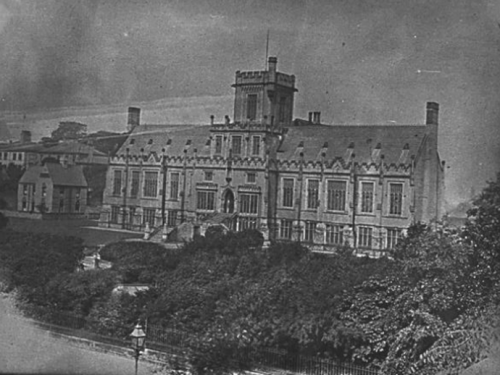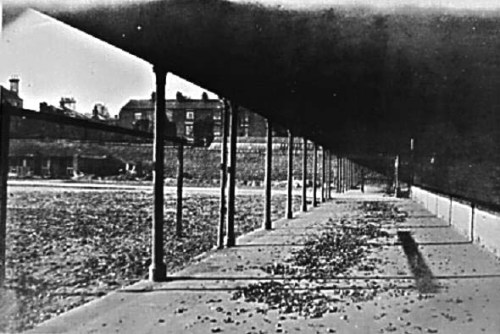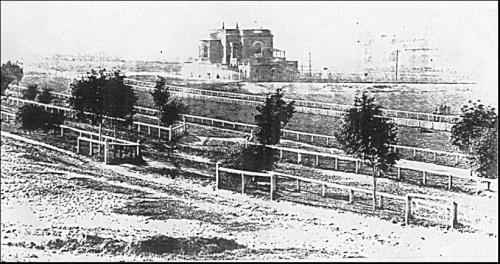This is the first section of an eventual four, all of which will tell the story of the remarkable characters who have worked as caretakers at the High School over the last 150 years.
When I first became a teacher, my Dad, who had spent most of his life doing exactly that same job, gave me some valuable advice. He asked me “Who is the most important person in any school?”
I gave him a list of likely candidates, but he dismissed them all as incorrect by some margin. The correct answer of course, was “The caretaker.” If there is no Head Teacher, it’s no problem, and lessons will go on. A teacher is missing, off sick? Somebody else will cover the lessons, no problem. No caretaker and the toilets are blocked? No school, we all have to go home!”
I have found it more or less impossible, though, to create a complete list of High School caretakers over the last 150 or so years, because such men are quite simply not considered to be important enough to be remembered, unlike Headmasters, the names of which are all displayed on the wall behind the Reception Desk.
That is not to say, however, that the High School does not value its caretakers very highly. In school magazines such as “The Nottinghamian” and before that, “The Forester”, there are many affectionate reminiscences either by or about the school’s caretakers. And in these reminiscences, it soon becomes abundantly clear that the High School’s caretakers have always been very popular, well loved figures, especially with the boys.
William Knowles Keach was one of the very first caretakers, towards the end of the nineteenth century. His daughter provided some trips down Memory Lane from the period 1880-1883…
“My father, Mr.Keach, was the first caretaker of the School when it was moved to its present site in 1868 ; he remained until about 1890 : for some unknown reason, he was always known as Knowles, or by the affectionate nickname “Knolley”. He was initially employed by Lawyer Patchett , a leading Nottingham figure. My father was an expert at his work for which he received 13s. 0d. a week, but lost his pay during “wet time.”, that is to say, periods when rain forced him to wait inside for the weather to improve. Mr.Patchett suggested to my father that he should try for the job at the new school which was being built. Naturally, my mother was consulted, and she thought it “a good thing, Bill” since the wage was to be 18s. 0d. a week, plus house, coal and gas, with no loss of money in wet weather. Children, however, were frowned upon, but my father gave an assurance that there would be no trouble, and his application was successful. The caretaker’s house was at that time a part of the school building and consisted of a kitchen and parlour on the ground floor, a cellar and three bedrooms upstairs – one over the side door, another over the bay window, and the third over Mr Liddell’s classroom (later 4A room). I was born in this house in 1870, and lived there with my father and mother, three brothers and three sisters. The family did all the caretaking and cleaning in the school. My father was also responsible for the upkeep of the grounds and garden:
He did all the lawn mowing, and supervised the removal of the sandstone when the yard and gardens of to-day were excavated – no small task. In winter we helped him to clear snow from the paths. For general repairs a Mr. Rushworth was called in. He was known as “quarter-to-three” feet, on account of the way he walked!
In those days the school yard was all open country, with grass and gorse bushes. There was no wall on Forest Road, a street where windmills still stood or had perhaps only recently disappeared. There were no railings on Arboretum Street, just a rough fence. The grounds immediately around the buildings consisted of sandstone outcrops, loose sand and plantations of trees and shrubs, some of which were on the site of the present caretaker’s house and the present Music Room, though at a higher level. Here is some of that loose sand, still there in the 1930s:
The Headmaster, Dr, Dixon, lived in the end house of Waverley Mount (then called Clarendon Road). This house later became part of the “Preparatory School.”, and was demolished to build the present building. The other part of the large house was occupied by Mr. Taylor, the veterinarian. Many years later the great “Drawing Room” with its barrel roof was built on top of the north wing, and our house had to be partly demolished to make way for it. The present caretaker’s house was then built. Mr.Tait was responsible for the erection, under Mr.Patchett’s direction, and Mr.Jelly was the joiner for the Drawing Room. There was a bit of jealousy between them about the cost.”
In 1880 a new and rather grand sounding Porter’s Lodge was completed to the south east of what is now called Waverley Mount. Previously, Mr.Keach, aka Mr.Knowles, had lived with his family in a room at the southern end of the class-room corridor (near present day W2). As mentioned above, his wife had given birth to at least one baby in this rather cramped accommodation. Young Miss Keach appears to be the only baby ever born in the High School, unless, of course, somebody knows better….
Mr.Knowles, as School Caretaker, had the duty of locking up all the gates on Forest Road at 2.15p.m. His greatest delight was to lock up just before the appointed time, and then beam at the small batch of boys who came running up from the Forest, where they had stayed to see the first horse race, which was generally timed to start at 2 o’clock. This meant their running round Waverley Street to another school entrance and a bad mark if they were late! Here is the Forest in the 1880s, looking down towards the horse racing course:
Mr.Knowles was also remembered for the occasions when he would come to put extra coal on the huge coal fires which were used to heat every classroom. If the Master’s desk was sited in the correct position, “Knolley” was able to go up behind the Master with his dirty, blackened, coal encrusted hands and pretend to move forward and seize the Master’s often bald head, as if to leave black sooty handprints on it. This caused enormous merriment among the watching schoolboys.
This marvellous photograph shows the school at the end of the nineteenth century. Notice the many chimneys all contained in large chimney stacks, and all obviously requiring frequent injections of fresh coal. Notice also the three boys lounging at the corner of the building. Their companion is sitting on the edge of the tennis court:
On Wednesday, December 21st 1898 the High School broke up for Christmas, and Mr.Knowles, now the School Porter, retired after thirty three years of service. The school prefects had organised a collection, and the boys of the school contributed over £33. This enormous sum of money was used to purchase a “handsome easy chair, and a case of silver spoons”. The balance, a total of twenty five sovereigns, was presented to Mr.and Mrs.Knowles by W.A.Blackwall and the other prefects, together with a beautifully illuminated address.
This article will be continued in the near future.









Your father was quite right in his assessment of the caretaker’s value. As in many other areas, the people ‘behind the scenes’ are the most important.
Absolutely! And the leaders who enjoy giving orders can easily be replaced by a ten minute meeting where the so-called followers work out what to do and how to do it.
I’ve seen it happen!
So if they were given the 25 sovereign in cash what other monies would a retiring porter get for his retirement?
Well, I’m no expert, but I suspect that there would have been nothing else. There was certainly no old age pension, as there is now. His accommodation too went with the job, so retirement meant he was perhaps homeless, unless he had thought well ahead. Until the Labour Government of 1945, England could be a very cruel place.
Sadly I remember my days in high school when the kids made fun of the janitor, the name we have for caretakers. I like the name caretakers better. Really enjoyed reading your post, John. ❤
Thanks very much, Amy. Very often the most humble of people have their tale to tell or a lovely character to share with their fellow human beings.
In my first post, I worked at a C of E school and we had a caretaker who lived in the school house that came with the job. They bought it off the authority but it always amazed me that school still had adjoining homes for the caretakers. They are a wonderful bunch of people and your father was absolutely right, without them, the school won’t work.
I think it’s quite common for older schools to own properties. The problem is that they go with the job, and when people leave they may be homeless. Councils don’t make a huge effort to give council houses to old age pensioners. Caretakers are lovely people. Nobody seems to notice them, though. They work so much in the background.
All so true.
Having to go into school during the holidays to see to all things biological, the caretakers were brilliant. Unsung but of great support!
Absolutely. Most of them legends in their own lifetimes to hundreds of teachers and pupils. And underpaid legends at that.
Good story. Last week I had the pleasure of taking my grandchildren to school. The caretaker there is a jobsworth, “I will only open the gate at the stroke of nine” etc.
It won’t be anything personal with you. Health and Safety laws may not allow any overlap between kids in the yard and cars. He may well have been told that if kids and cars are ever there at the same time, he will be sacked on the spot. I have similar “local difficulties” sometimes when I go in to work in the school archives.
Well said, both by you and your father. Such a pity that the concept of care has gone out of so many of our services
Yes it has. So many people nowadays only think of promoting their own career with no concept of serving the people they are supposed to be helping. I suppose it’s a mixture of being overworked and underpaid, probably with a good helping of the “me, me, me” culture we have somehow created in recent years.
Very interesting story.
You reminded me watching “Scrubs” – Janitor was the best character 🙂
Yes, I agree with you. And janitors always know so much about everything that is going on. That is why they make such good characters on TV.
Thank you for sharing. Teaching has always been a part of my life. My grandfather was the headmaster of the Municipal High school where he lived till he retired. My husband is a Dental Surgeon and a teacher. Recently I had been reading books by one Miss Read and they are all about school life in the first half of the 20th century. Regards.
You sound like a family who is wholly convinced of the value of a good education! Thank you for your interest….and three more sections to go.
Pingback: the Reverend Charles Stephens (1) | John Knifton